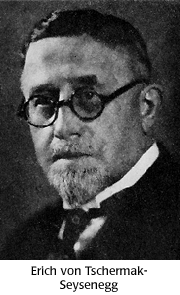Concept 6 Genes are real things.




 Hugo de Vries, Carl Correns and Erich von Tschermak-Seysenegg were the three scientists who rediscovered Mendel's laws in 1900. They were all working independently on different plant hybrids, and came to the same conclusions about inheritance as Mendel. Robert Hooke was one of the first scientists to describe a cell. Theodor Schwann redefined the cell as a living unit.
Hugo de Vries, Carl Correns and Erich von Tschermak-Seysenegg were the three scientists who rediscovered Mendel's laws in 1900. They were all working independently on different plant hybrids, and came to the same conclusions about inheritance as Mendel. Robert Hooke was one of the first scientists to describe a cell. Theodor Schwann redefined the cell as a living unit.
Erich von Tschermak (1871-1962)

Erich von Tschermak-Seysenegg was born in Vienna, Austria. His father was a well-known mineralogist, and his maternal grandfather was the famous botanist, Eduard Fenzl, who taught Gregor Mendel at one point. He studied agriculture at the University of Vienna, and worked on a farm to gain practical agricultural experience. Tschermak graduated with a doctorate from the Halle-Wittenberg University.
In 1898, he started doing plant breeding experiments using peas, and by 1900, he had written up his results. Tschermak, like de Vries and Correns, independently derived "Mendelian" laws of inheritance from his plant experiments. Because he was younger, and not as established in the scientific community, Tschermak was worried about the acceptance of his paper given those of de Vries' and Correns'. However, he was able to rush his paper to press, and was accorded his share of attention as one of the rediscoverers of Mendel's laws.
Tschermak was a plant breeder, and his hybridization experiments were done with the idea of improving crops using the laws of heredity. He did most of the work himself, and produced high-yielding food crops such as wheat, barley, and oats. In 1903, Tschermak was appointed associate professor at the University of Agricultural Sciences in Vienna, and later became a full professor. He was a major influence in agriculture and plant breeding in Austria.


Theodor Schwann recognized that eggs, ova, are cells. In 1841, sperm were classified as cells when they were seen developing from testis cells.

What is the largest single cell in existence?
 Children resemble their parents.
Children resemble their parents. Genes come in pairs.
Genes come in pairs. Genes don't blend.
Genes don't blend. Some genes are dominant.
Some genes are dominant. Genetic inheritance follows rules.
Genetic inheritance follows rules. Genes are real things.
Genes are real things. All cells arise from pre-existing cells.
All cells arise from pre-existing cells. Sex cells have one set of chromosomes; body cells have two.
Sex cells have one set of chromosomes; body cells have two. Specialized chromosomes determine sex.
Specialized chromosomes determine sex. Chromosomes carry genes.
Chromosomes carry genes. Genes get shuffled when chromosomes exchange pieces.
Genes get shuffled when chromosomes exchange pieces. Evolution begins with the inheritance of gene variations.
Evolution begins with the inheritance of gene variations. Mendelian laws apply to human beings.
Mendelian laws apply to human beings. Mendelian genetics cannot fully explain human health and behavior.
Mendelian genetics cannot fully explain human health and behavior.